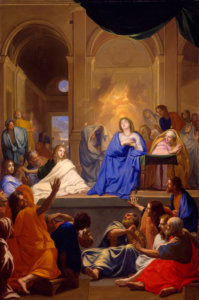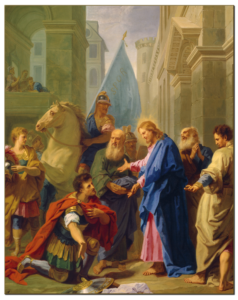Pentecost
Oil on canvas
Charles Le Brun
French, 1619–1690
Though perhaps not as well known today, the fame of this French artist outlasted his years for at least a century, if not longer. Charles Le Brun was born February 24, 1619 and died twelve days before his 72nd birthday in 1690.
Le Brun was recognized for his prodigious talent at only 11 years of age, when he was noticed by the Chancellor of France, Louis Seguier. The Chancellor connected Charles with Simon Vouet, one of France’s most important painters of the seventeenth century (and also represented in M&G’s collection by two works, King David Playing the Harp and Salome with the Head of John the Baptist). He furthered his artistic study in Rome under fellow countryman Nicolas Poussin, developing a more classical Baroque style.
Charles had the skill and opportunities to develop political connections with French nobility and royalty, earning commissions and support from the most powerful of the French court. He was one of the twelve founding directors of the French Royal Academy of Painting and Sculpture, accepting leadership of it under the Sun King, Louis XIV and his powerful advisor, First Minister of State Jean-Baptiste Colbert. Unfortunately, as Charles’ successes increased, he snubbed his teacher Vouet, excluding him from involvement in the academy.
Le Brun’s influence and administrative ability enabled him to direct and determine the style of painting and design from a royal perspective. His texts, theories, and styles would be followed for at least a century. He is credited with making Paris the center of the art world, eclipsing the position first held by Rome. Many other works for which he was responsible as either artist or director are found in the great edifices of Versailles and Vaux-le-Vicomte.
Acquired in 1965, M&G’s Pentecost is a modello or final color study for a large altarpiece of the same subject Le Brun painted for the chapel of the seminary of St. Sulpice (now St Honoré-d’Eylau) in Paris. Engraved copies exist and attest to Le Brun’s ability and popularity. On the middle left, the figure looking out at the viewer is none other than the artist himself—Charles Le Brun, around 37 years old and in the prime of his career. By including himself in this occasion, he not only reveals himself as the artist but also as a disciple inviting the viewer to participate in the event. Le Brun transported the believers and the spectators of the painting to a classical architectural representation of the upper room for the place of the Spirit’s descent.
Christ told His disciples to stay in Jerusalem until the Comforter or the Holy Spirit came. Acts 2 gives account of the fulfillment of Christ’s promise. The coming of the Spirit was the source of comfort and power for the early church to successfully carry out the work that Christ commissioned them to do in Matthew 28:18-20. Pentecost was not only a Jewish feast in the Old Testament, but it was the beginning of the Holy Spirit’s work that continues today. It was more than a historical event. True believers today are also indwelt by the same Spirit and commanded to be Spirit-filled as the apostle Paul wrote in Ephesians 5:18.
As you consider this painting and Le Brun’s invitation, may you also remember his February birthday and the wonderful truths of God’s Word that the Comforter has indeed come. “But the Comforter, which is the Holy Ghost, whom the Father will send in my name, he shall teach you all things, and bring all things to your remembrance, whatsoever I have said unto you” John 14:26.
John Good
M&G volunteer and former M&G docent and Security Manager
Published 2023

